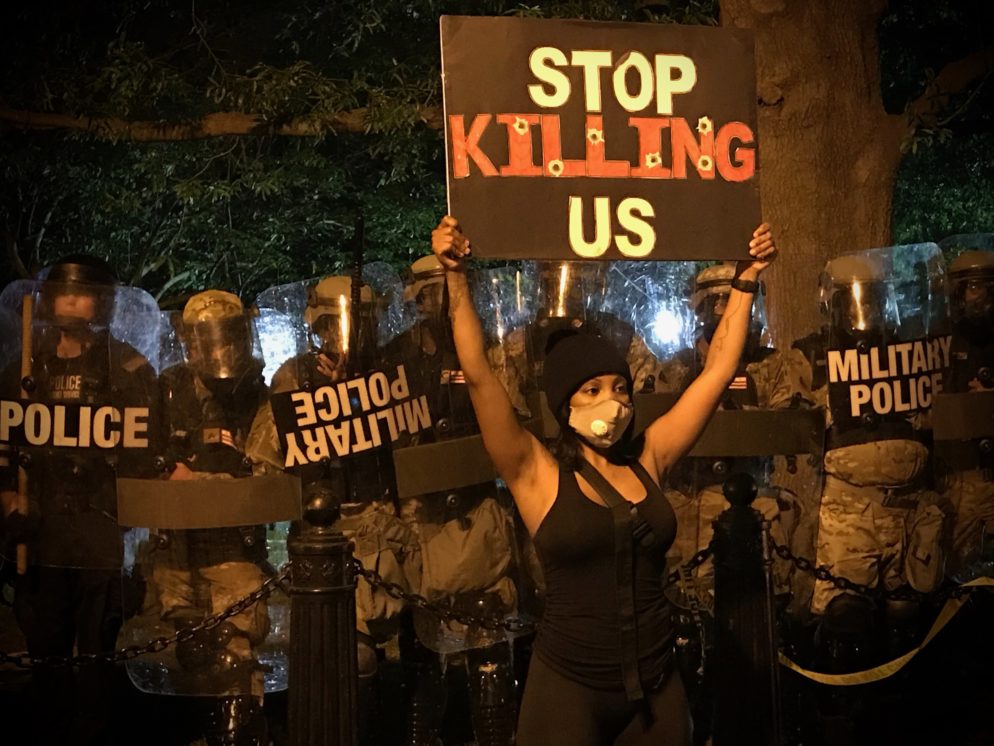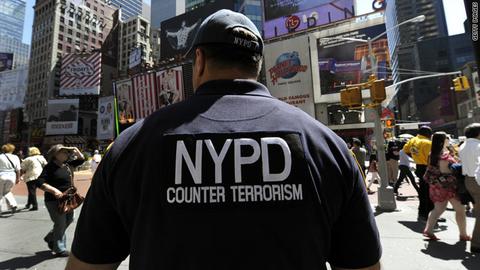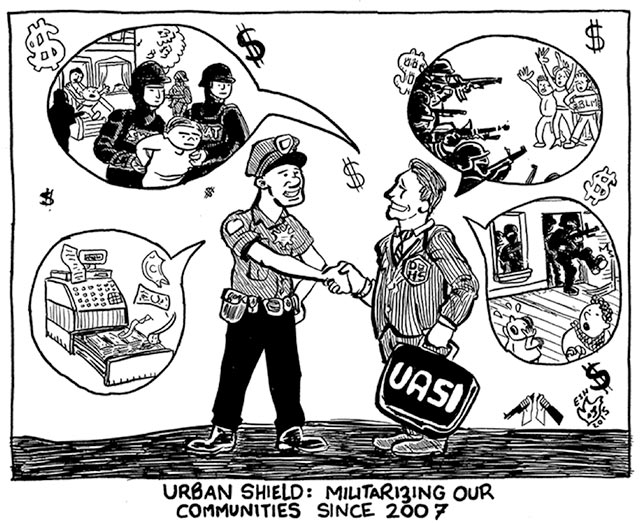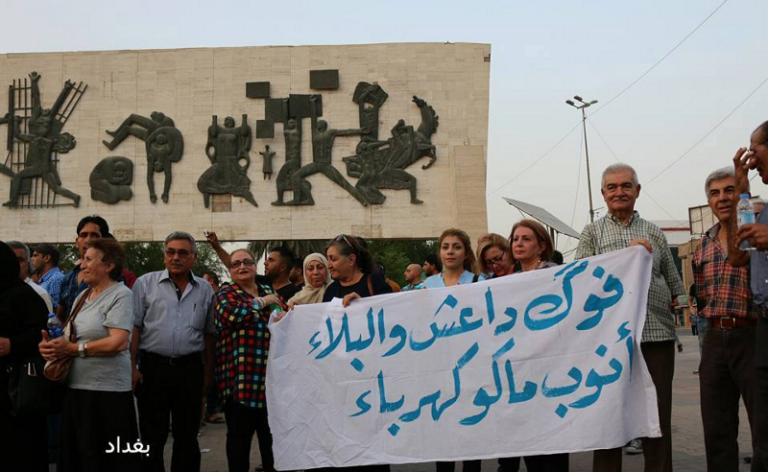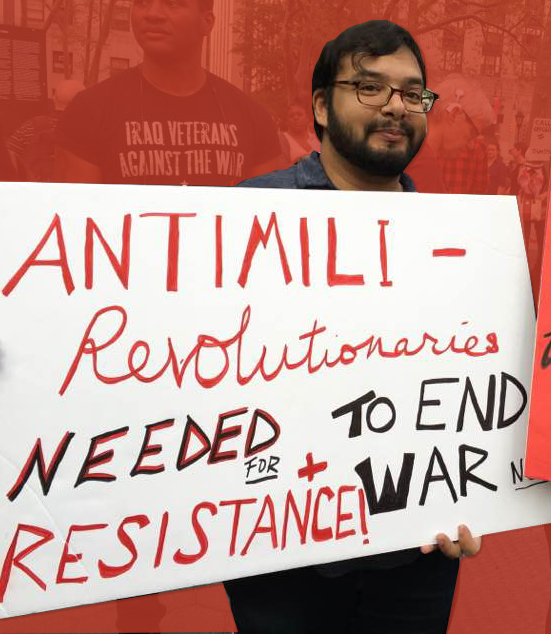A Revolutionary Nonviolent Perspective on US Uprisings
July 9, 2020
Previoulsly published on Waging Nonviolence
We are activists, we are practitioners of revolutionary nonviolence, and we are outraged. Outraged at the 400-year long history of violence against Black people in this country; outraged at the racist and murderous system that founded police, who kill Black people with impunity; outraged at the state-sanctioned brutality meeting Black Lives Matter protesters in the streets. We are outraged by the deployment of an old narrative that uses a false ideal of “peaceful protest” to justify the use of excessive force against protesters in the name of “restoring peace.”
So far, in response to the recent uprisings in defense of Black lives we have seen: the use of tear gas in more than 99 U.S. cities, nightly curfews imposed to criminalize protesters en masse, National Guard troops and militarized tactics used in our own cities and towns, and thousands of people arrested nationwide — all acts that are egregious on their own, but especially so during a pandemic.
We are here to debunk the myths of “peaceful protest” from the state, to correct the framing of violence, and to offer an understanding of the rage and outrage we’re seeing right now within a tradition of revolutionary nonviolent resistance. As one of the oldest antiwar organizations in the United States with a theory of change that’s rooted in revolutionary nonviolence, we recognize the state’s cooptation of “peaceful protest” as a tired tactic — one which has been used before to divide our movements for collective liberation and will be used again.
The first myth is that “peaceful” action is the opposite of violence. This myth creates a false dichotomy between “peaceful protesters,” as the media calls them, and “rioters, looters, and statue destroyers bent on erasing history” — the latter who require a show of force from the state in order to return to “law and order.”
In truth, what we are seeing on the streets are not “peaceful” protests, but rather nonviolent protests seeking to confront and disrupt the violence of U.S. police. The distinction isn’t merely semantics — typically protests seek city permits and accept police presence in order to occur. Today’s protests take place without permits, and therefore without permission of the state, and this act of disruption is not peaceful, but rather organically confrontational, and precisely what makes it an uprising. Furthermore, taking the streets and preventing business as usual are nonviolent means of resistance — as Martin Luther King, Jr. said in his Letter from a Birmingham Jail in 1963: “Nonviolent direct action seeks to create such a crisis and foster such a tension that a community which has constantly refused to negotiate is forced to confront the issue. It seeks so to dramatize the issue that it can no longer be ignored.”
The second myth is that white people are enlightened to resist nonviolently and more acceptably on the terms of the state. In turn, Black protesters are especially criminalized for being “not peaceful.” Contrast this myth with the reality: that the very concept of revolutionary nonviolence was introduced to the United States by Black organizers. Our own work is rooted in the tradition of revolutionary nonviolence that first came to the United States by way of Harlem in the 1940s — when Black people working to end segregation adopted the strategies and tactics of a movement halfway around the world in India, which have been carried forward to this day by communities of color struggling towards the goal of racial justice and up-ending white supremacy.
The third myth we need to tackle is that actions taken by protesters — particularly those that result in property damage — are more dangerous than the systemic violence of policing. The state, taking advantage of moments of acute public rage, will always present property damage as an act of violence. And because people in the United States live under capitalism and are inundated with messaging on owning and protecting property as a virtue, many audiences either outright accept this framing or struggle to refute it. Similarly, we are also seeing “peace policing” in our movements where protesters are blamed and ostracized by other protesters, who are replicating the state’s role, for property destruction and for defending themselves against police. The issue is not as clear cut as the state’s narrative presents it.
There is a long history of nonviolent activists purposely destroying or damaging property as part of strategic resistance: first by enslaved people, who engaged in property destruction as acts of rebellion taken by people who were themselves considered to be property, or more recently, activists in the Plowshares movement, who take hammers to weapons in response to the Biblical call to “beat swords into plowshares.” Particularly in moments of rage, when property destruction is deemed by the state as “chaotic,” we encounter a narrative that tells a two-sided story framing the “violence” of protesters as a greater threat to collective safety than the threats policing, ICE agents, and austerity budgets introduce to our communities.
The state also posits that protesters are the instigators, and that is why the police must respond with force — as opposed to policing being the original violence. This narrative is not only backwards but plays into the hand of white supremacist logic and a ruling class elitism designed to dehumanize communities that are forced to struggle for freedom from oppression. So long as the state, aided by corporate media, can successfully characterize oppressed communities as “dangerous,” state-sanctioned violence is framed in a comparative lens and justified.
This tactic can be very effective, but the “violence” of protesters and the violence of the state is simply incomparable. In 2019 alone, police murdered over 1,000 people without repercussion. As Donald Trump, state, and local officials around the country stoked fears of looting, corporations and the Pentagon took billions in stimulus money that could have otherwise gone towards meeting the material needs of millions of Americans. This, on top of a national origin story based on the plundering of Indigenous communities and Black communities, gives us the perspective to understand who is looting who. And yet, the federal government is ready to put two human rights lawyers in prison for life for allegedly attempting to destroy property. In this case, we need to recognize that violence from the state far outweighs the violence allegedly enacted on an empty vehicle.
As nonviolent activists we cannot permit a narrative that describes violent and nonviolent acts of protest as a binary, where only the latter is perceived as a legitimate form of resistance. To fear the “violence” of property destruction more than we fear the violence of the state is to choose a world in which individuals with the privilege of living lives that already matter to the “system” (white lives, “productive” lives that generate capital, etc.) continue uninterrupted, while Black communities bear the burden of death by the system in which we live. Revolutionary nonviolence is a tool in our struggle for freedom. We will not allow the calls to be “peaceful” to become a weapon to be wielded against the least free among us. No one is free until we are all free.
Finally, as we take in all this summer has brought and continues to bring in the way of resistance and power, we hold fast to the knowledge that this moment does not stand alone in time. The incredible groundswell of protest in defense of Black life stands on the shoulders of decades of movement work and struggle that have been waged and won using tactics from every part of the spectrum of resistance. The power we’re seeing on the streets is a coalescence of decades of work for racial justice and Black liberation in the United States. The struggles for abolition of slavery, for desegregation, and for civil rights that taught us the meaning of resistance; Black feminists’ demands for abolition of the prison industrial complex and policing, nurtured and carried forward by organizations like Critical Resistance; and a widespread awakening ignited by the Movement for Black Lives that systemic change must come through the uprooting of the very culture, laws and institutions we live in.
Rage will always be part of our movements, as it is a natural response to horrific acts of violence and injustice. Anger is a healthy response. Anger at injustice gives rise to nonviolent social change.
Share

